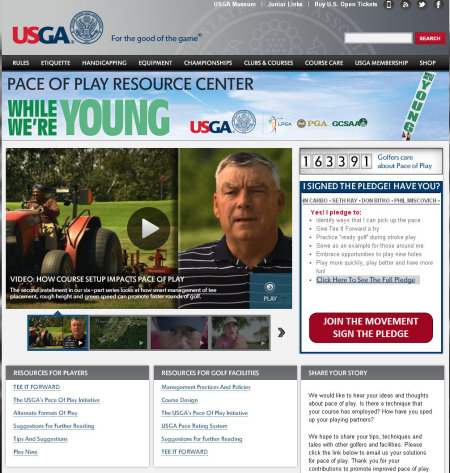 As part of its initiative to address pace-of-play issues in the game of golf, the United States Golf Association (USGA) has introduced a series of educational tools designed to educate the golf community on the factors that influence the time it takes to play the game.
As part of its initiative to address pace-of-play issues in the game of golf, the United States Golf Association (USGA) has introduced a series of educational tools designed to educate the golf community on the factors that influence the time it takes to play the game.
The new tools include a series of six videos that address the following topics:
- Why traffic jams occur on the course
- How course setup impacts pace of play
- Improving pace of play around the green
- Being prepared to hit
- When disaster strikes
- Alternative formats
The first two videos (“Why traffic jams occur on the course” and “How course setup impacts pace of play”) can be viewed by visiting the USGA’s Pace of Play Resource Center at www.usga.org/whilewereyoung. Additional videos will be introduced through the rest of the year.
“The USGA is making significant progress on addressing pace-of-play issues in the game, pursuing real solutions that consider all of the factors that contribute to longer playing times,” said USGA Executive Director Mike Davis. “These videos bring the key challenges to light in an engaging and creative manner that will help meet our goal of educating and mobilizing the entire golf community to understand the causes of slow play and to be part of the solution.”
The narrators for the videos are “Today” host Matt Lauer, Headline News anchor Robin Meade and 2004 U.S. Senior Open champion Peter Jacobsen. Some of the country’s top teaching professionals also contribute to the video series.
“Pace of play is an issue, no doubt about it,” said Jacobsen. “From the pro game that I’ve been part of for many years right down to the friendly match at a local course, nobody likes a five-hour round. These videos do a great job in helping viewers understand that it’s not just about us golfers – it’s a problem with a lot of moving parts. I believe that collectively we can solve this and that’s why I decided to help out.”
The videos build on the USGA’s “While We’re Young” campaign, which has created greater awareness of pace of play within the golf community. In addition to viewing the new educational videos, visitors to www.usga.org/whilewereyoung will be able to join the thousands of fellow golfers who have signed a pledge to take personal measures to improve pace of play. Once they have viewed all six videos, pledge signees will receive a certificate recognizing them as a USGA pace-of-play ambassador.
Launched in February 2013, the USGA’s initiative is leading the golf industry toward reducing the time that it takes to play in order to help ensure the game’s sustainability for current and future generations of golfers. Some of the programs comprising this initiative include a symposium on Nov. 7, the utilization of a pace-of-play model based on player data, the development of several tools to help golf facilities manage pace of play at their courses, and the creation of “While We’re Young” promotional materials.
USGA www.usga.org


